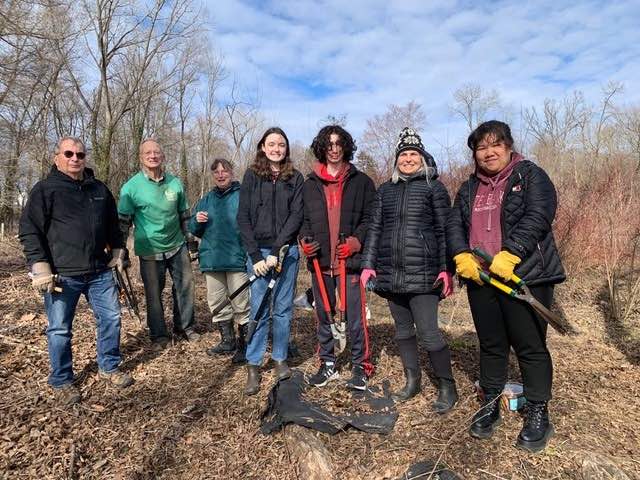Stop the English Ivy Invasion
- Thursday, 04 May 2023 09:25
- Last Updated: Friday, 05 May 2023 21:50
- Published: Thursday, 04 May 2023 09:25
- Joanne Wallenstein
- Hits: 1239
 This article was submitted by Madelaine Eppenstein President of the Friends of Scarsdale Parks
This article was submitted by Madelaine Eppenstein President of the Friends of Scarsdale Parks
English ivy, an aggressively invasive, non-native evergreen vine, is literally engulfing and destroying Scarsdale’s majestic shade trees and evergreen conifers. While some consider an evergreen cover on tree trunks to be attractive, allowing vines to grow on trees is dangerous and potentially fatal to even the largest mature tree. English ivy is considered an “invasive species” in New York State, defined as “non-native to the ecosystem under consideration. . . whose introduction causes or is likely to cause economic or environmental harm or harm to human health.” Ivy blocks sunlight from reaching a tree’s own leaves, which weakens the tree by impeding photosynthesis. Ivy usurps nutrients and water from soil, depleting a tree’s resources. Adding significant weight to tree branches, ivy makes them more susceptible to damage from high winds, heavy ice, and snow.
We urge Scarsdale’s homeowners, landscapers, and government to take action to protect village trees from English ivy vine damage. Besides the enormous cost of removing dead or dying trees, losing trees means losing the significant environmental services that trees provide to filter air by capturing carbon and releasing oxygen, slow and absorb runoff and flooding, cool homes in summer, and provide food and shelter for songbirds and other wildlife.
To save our trees residents can help remove destructive ivy and other invasive vines and prevent further injury. This is the technique favored by Friends of Scarsdale Parks, Inc. (FOSP), the environmental nonprofit active in Scarsdale since 1957, and practiced by other local groups including the Bronx River Parkway Reservation Conservancy.
Using pruners, loppers, and hand saws to cut the vines, remove and discard a section approximately 12-24 inches long on the lower part of the trunk, taking care not to damage the tree’s bark. Do not pull the remaining ivy off the trunk, as this may damage the tree or cause upper tree branches to fall. While some experts have recommended painting the cut ends of ivy with pesticide, this should be done only by professionals and avoided due to the health and safety dangers of pesticides as acknowledged in the recently codified Village policy banning most uses of pesticides on public property.
Before tackling the ivy, make sure you can distinguish English ivy and avoid contact with poison ivy. Wear long sleeves, pants, socks, and gloves to protect yourself from poison ivy and ticks. Or instruct your landscaper to emancipate your trees now as part of spring clean-up, or any time after the tree leaves have fallen in fall or winter.
 Vine cutting session at the Harwood Park wetland restoration site along Brewster Road, attended by FOSP board members and student liaison, Scarsdale HS Garden Club members, and two former Scarsdale mayors. Photos by Cynthia Roberts.
Vine cutting session at the Harwood Park wetland restoration site along Brewster Road, attended by FOSP board members and student liaison, Scarsdale HS Garden Club members, and two former Scarsdale mayors. Photos by Cynthia Roberts.
We invite the community to participate in the effort to save Scarsdale’s trees beginning with the trees on your own residential properties. Please contact us at meppenstein@eppenstein.com or 914-262-6656 if you have any questions, or would like to join in an organized community effort to save our trees from harmful vines. Learn more about English ivy and other invasive species, and find useful how-to information here and here. Join Pollinator Pathway by removing invasives, planting natives, and avoiding pesticides at https://www.pollinator-pathway.org/.
Madelaine Eppenstein, FOSP President
Cynthia Roberts, FOSP Vice President
Dr. Darlene LeFrancois Haber, Scarsdale Forum Inc. Sustainability Committee Chair